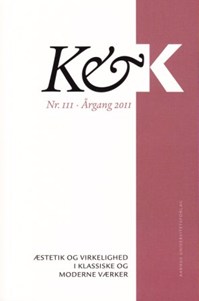Den bogstavelig død. Det neobarokke vanitasmotiv i Durs Grünbeins "I provinsen" (1999)
DOI:
https://doi.org/10.7146/kok.v39i111.15757Nøgleord:
Durs Grünbein, neo-baroque, vanitas, In der Provinz, postmodernism, metaphysics, Nach den SatirenResumé
THE LITERAL DEATH. THE NEO-BAROQUE VANITAS MOTIF IN “IN THE PROVINCE”
This paper investigates the use of Baroque imagery in the cycle of vanity poems “In the Province” (OIn der Provinz”) (1999) by the German poet Durs Grünbein (1962-). GrünbeinOs poetics revolves around a notion of human life as essentially material and physical. In his treatment of death, this point of view connects him with Baroque vanity poetry following the tradition of Andreas Gryphius (1616-1664). On the basis of a concept of a transhistorical Baroque discourse, I discern a negotiation of Baroque tropes in the poems, focusing on the use of antithetical, analogical, and allegorical figures, as well as an objectifying gaze similar to that of the Baroque vanitas painting. Shifting the metaphysical framework of the historical Baroque to a predominantly physical one, Grünbein reinstates the value of the individual in its bodily existence, thereby reinterpreting the meaning of the OvanityO of material things. Comparing this formal remodelling to the postmodernist and modernist Neo-Baroque concepts, I argue that a reading of Grünbein’s vanitas can be used in a new conceptualization of the Neo-Baroque, which I term ‘dialogical’.
Downloads
Publiceret
Citation/Eksport
Nummer
Sektion
Licens
Tidsskriftet følger dansk ophavsret.





